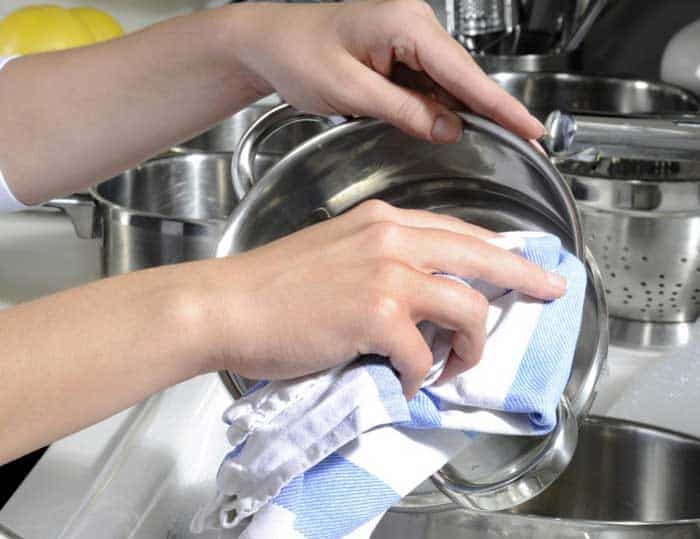Clean Sticky Rice, Remove Limescale, Black Stains From A Rice Cooker
A rice cooker can be a great appliance to have in your kitchen. It can make a variety of side dishes and meal options along with rice.
That being said, the process of cooking rice is messy. There are often rice grains that stick to the bottom of the pot, making it difficult to clean. It can also cause problems with its buildup of limescale.
Even the best models can be challenging to clean properly. For example, it’s easy enough to use water outside your rice cooker, but you want something that will remove stains and sticky goo from inside the machine.
And when you are making some spicy Indian food, these cookers are notorious for getting tough stains, burnt food, and stuck-on leftovers. You can’t just use water to clean these devices. You need to use specialized cleaning agents for this purpose.
Cleaning a rice cooker is a tedious task. However, there are several methods to make it easier. This step-by-step guide will teach you how to clean your rice cooker in a professional way to make it look brand new again.
How Do You Clean Sticky Rice In A Rice Cooker?
While there are many ways to clean sticky rice, the easiest way is to pour boiling water into your pan and then leave it for about an hour. This will loosen any stuck or stuck-together rice grains so you can easily remove them with a spatula or spoon.
Many cooks use lemons or limes in their rice cookers to add flavor, but this also makes it difficult to remove stains from your cooker. Cleaning a rice cooker can be difficult and frustrating, but it is important to clean the rice cooker every time you use it.

This way, you will avoid any bacteria or other harmful substances that may be present in your rice. Rice stuck to the bottom of a rice cooker is a common issue. Here are a few methods you can use to clean this sticky stuff.
Simple Cleaning Hacks:

- Put the lid on and let the water boil inside for 10 minutes. This will help loosen up anything stuck on the bottom of the rice bowl.
- Turn your machine upside down and pour water over it. Keep pouring until all of the sticky stuff is gone from inside of the machine.
- Then use a sponge to wipe the bottom of the bowl and walls with soap and water (soap will break down dirt).
Cleaning Sticky Rice In A Rice Cooker After Cooking:

- Fill the pot with water and add in 1/4 cup white vinegar and stir well. Leave the closed lid on for 1-2 hours. Drain it out, rinse off with warm water and dry your cooker well before using it again.
- For more thorough cleaning, scrub gently at the bottom of your pot with soap or a toothbrush to remove any stuck-on bits of rice. Next, add a tablespoon of salt and 3 cups of water, cover it up, and let sit for 15 minutes before draining out excess water from the pot.
Precautions
Rice cooker cleaning can be a time-consuming and challenging process that is why you might be tempted to use chemical agents. The rice cooker’s hot plate and inner cavity are areas where chemical cleaners can get trapped and cause serious damage to your rice cooker.
Whether you’re cooking rice or cleaning your house, you should never use chemical cleaners. They can corrode the outer layer of the cooker and ruin its performance.
If you want to avoid this, you should use a damp cloth or sponge to clean these areas. Do this as a last resort when all else fails. Take a damp rag and wipe down the appliance if some of the chemicals got inside due to using a chemical cleaner.

It is recommended that you clean the cooker’s inside with plain warm water or a solution of vinegar and water before trying anything else.
How To Remove Limescale From A Rice Cooker?
Limescale buildup can accumulate inside a rice cooker because it is designed to be immersed in water. If left untreated, the buildup can negatively affect the taste and texture of your rice as well as the longevity of your device.
This buildup is common among those who use their rice cooker every day. For example, when you open your cooker for cooking, you might notice that it has a layer of white film on top and that these layers build up over time.

If you find that your rice cooker is producing a lot of steam but is not cooking, then this might be the issue. Limescale deposits found in the bottom of the rice cooker may make rice taste bad or even corrode the pot, but fortunately, there is a way to remove them without any hassle.
With Vinegar
In order to clean the limescale from the cooker, you will need to pour boiling water into it. After this, you will need to run it through a cycle with white vinegar before removing all of the residues.

Limescale can be removed using diluted acetic acid in vinegar. Vinegar is used for many things, such as cleaning and cooking. It is also used to remove limescale from faucets. Ingredients such as acetic acid and water are mixed together and added to the rice bowl before it is soaked.
With Lemon
With the wrong tools and products, removing limescale from a rice cooker can be difficult. However, some natural acids are very effective in treating it, as well as very cheap. For example, lemon juice. This is probably the most effective method.
When life gives you lemons, use them to clean your rice cooker. Since we are dealing with a rice cooker here, you should only use vinegar or lemon or a combination of both.

Lemons contain citric acid, which helps break down limescale. However, if you’re using lemon juice to clean your dishes, stop using raw lemon juice. Instead, use a mixture of vinegar because it contains acetic acid.
Other Popular Methods
Limescale is a form of mineral deposit that forms on the surface of plumbing surfaces. It can be treated in several ways, including using white vinegar, baking soda, or salt. Let me show you how. Limescale can be treated in several ways, including:
Coke
The phosphoric acid contained in a coke can both remove rust and limescale. Phosphoric acid is a substance that can remove rust and limescale from metal surfaces.

It is also an ingredient in coke, and the phosphoric acid in a coke can both remove rust and limescale. The phosphoric acid in coke also has an anti-corrosive effect on metals such as aluminum, iron & steel.
Vinegar And Baking Soda Mixture
The fizzing reaction created by baking soda and vinegar can help dissolve almost anything, including limescale.
However, when you’re trying to clean the vinegar and baking soda mixture, it’s important to remember that there’s a chemical reaction occurring.

The acids in the mixture react with the alkali of the limescale, causing an exothermic reaction (also known as a fizzing reaction).
How Do You Remove Black Stains From A Rice Cooker?
Rice cooking has many benefits for you and your family, but this does not mean you should ignore the cleanup process. Cleaning off these black stains can be tough, but don’t worry – we’ve got your back!
A black stain on a rice cooker can be difficult to remove. This is because the rice cooker has a reactive plastic lining. However, you can clean it up with baking soda or white vinegar. This will remove all traces of the stains.

Rice cookers can get stained by a variety of things that include leftover food and greasy cooked rice. Because of this, it’s essential to know how to clean them, so they don’t stain the other items in your kitchen.
It is also important that you know how to clean your rice cooker after every use. This includes the lid, the steam vent, and the inner pot. There are a few ways you can clean your rice cooker, so it looks new again.
Cleaning Black Stains
The first step is to open the cooker and empty out all of the rice. Next, you should take a scouring pad or cloth and put some soapy water on it. Then, scrub away until there are no traces of brown residue left in the pot or around the edges.
It may be tempting to use chemical agents instead, but these chemicals can damage the ceramic coating on your cooker and its sealant.

Some of the most common ways to remove black stains on a rice cooker are through boiling water, using a scrubber, and soaking in bleach. If you want to remove hard-to-clean stains on your rice cooker, try these three easy steps:
- Fill up your sink with cold water and add some vinegar.
- Place the rice cooker into the sink and let it soak for 10 minutes.
- Scrub off with an abrasive sponge or toothbrush
Rice Cooker Maintenance
Rice cookers are the best way to prepare delicious and healthy meals. They are easy to use, affordable, and versatile. However, as with any appliance, they must be properly maintained for them to work effectively.
Regular rice cooker maintenance can extend the life of your appliance since proper care prolongs its lifespan and keeps it in good working order.

It is essential for all rice cookers that want to maintain their performance throughout the cooking process. Here are some of the most important steps that every rice cooker owner should know:
- Empty contents of the pot after each use
- Remove any food residue from inside and outside of the pot by wiping with a damp cloth or soft brush
- Wipe down the outside surfaces with a damp cloth to remove any dirt or debris that may accumulate
- Clean the lids and water levels on top of each compartment
- Pour out any extra water after washing the cooker and let it air dry
- Use vinegar or lemon juice on stubborn stains
Final Words
Rice cookers are a hot commodity in the kitchen. They are usually the appliance that is used the most, but they too often end up looking worn-out and dirty. Cleaning your rice cooker is not rocket science.
One of the most important steps in cleaning your rice cooker is making sure that the pot is rinsed out with water before placing it back on the stove. Regularly cleaning your rice cooker is an important step in ensuring it lasts as long as possible and without the hassle of scrubbing out the pot.
This way, you can prevent most of the cleaning hassles. It will also prevent black stains and limescale buildup. Also, don’t worry about sticky rice; they are fairly easy to clean. Make sure to follow the steps mentioned here.






